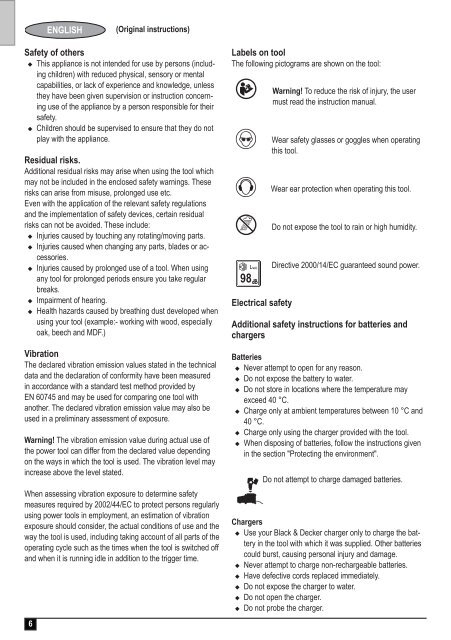BlackandDecker Taille-Haies S/f- Gtc1850l - Type H1 - Eu - Instruction Manual (Européen)
BlackandDecker Taille-Haies S/f- Gtc1850l - Type H1 - Eu - Instruction Manual (Européen)
BlackandDecker Taille-Haies S/f- Gtc1850l - Type H1 - Eu - Instruction Manual (Européen)
You also want an ePaper? Increase the reach of your titles
YUMPU automatically turns print PDFs into web optimized ePapers that Google loves.
ENGLISH<br />
(Original instructions)<br />
Safety of others<br />
u This appliance is not int<strong>en</strong>ded for use by persons (including<br />
childr<strong>en</strong>) with reduced physical, s<strong>en</strong>sory or m<strong>en</strong>tal<br />
capabilities, or lack of experi<strong>en</strong>ce and knowledge, unless<br />
they have be<strong>en</strong> giv<strong>en</strong> supervision or instruction concerning<br />
use of the appliance by a person responsible for their<br />
safety.<br />
u Childr<strong>en</strong> should be supervised to <strong>en</strong>sure that they do not<br />
play with the appliance.<br />
Residual risks.<br />
Additional residual risks may arise wh<strong>en</strong> using the tool which<br />
may not be included in the <strong>en</strong>closed safety warnings. These<br />
risks can arise from misuse, prolonged use etc.<br />
Ev<strong>en</strong> with the application of the relevant safety regulations<br />
and the implem<strong>en</strong>tation of safety devices, certain residual<br />
risks can not be avoided. These include:<br />
u Injuries caused by touching any rotating/moving parts.<br />
u Injuries caused wh<strong>en</strong> changing any parts, blades or accessories.<br />
u Injuries caused by prolonged use of a tool. Wh<strong>en</strong> using<br />
any tool for prolonged periods <strong>en</strong>sure you take regular<br />
breaks.<br />
u Impairm<strong>en</strong>t of hearing.<br />
u Health hazards caused by breathing dust developed wh<strong>en</strong><br />
using your tool (example:- working with wood, especially<br />
oak, beech and MDF.)<br />
Vibration<br />
The declared vibration emission values stated in the technical<br />
data and the declaration of conformity have be<strong>en</strong> measured<br />
in accordance with a standard test method provided by<br />
EN 60745 and may be used for comparing one tool with<br />
another. The declared vibration emission value may also be<br />
used in a preliminary assessm<strong>en</strong>t of exposure.<br />
Warning! The vibration emission value during actual use of<br />
the power tool can differ from the declared value dep<strong>en</strong>ding<br />
on the ways in which the tool is used. The vibration level may<br />
increase above the level stated.<br />
Wh<strong>en</strong> assessing vibration exposure to determine safety<br />
measures required by 2002/44/EC to protect persons regularly<br />
using power tools in employm<strong>en</strong>t, an estimation of vibration<br />
exposure should consider, the actual conditions of use and the<br />
way the tool is used, including taking account of all parts of the<br />
operating cycle such as the times wh<strong>en</strong> the tool is switched off<br />
and wh<strong>en</strong> it is running idle in addition to the trigger time.<br />
6<br />
Labels on tool<br />
The following pictograms are shown on the tool:<br />
:<br />
O<br />
N<br />
R<br />
98<br />
Electrical safety<br />
Warning! To reduce the risk of injury, the user<br />
must read the instruction manual.<br />
Wear safety glasses or goggles wh<strong>en</strong> operating<br />
this tool.<br />
Wear ear protection wh<strong>en</strong> operating this tool.<br />
Do not expose the tool to rain or high humidity.<br />
Directive 2000/14/EC guaranteed sound power.<br />
Additional safety instructions for batteries and<br />
chargers<br />
Batteries<br />
u Never attempt to op<strong>en</strong> for any reason.<br />
u Do not expose the battery to water.<br />
u Do not store in locations where the temperature may<br />
exceed 40 °C.<br />
u Charge only at ambi<strong>en</strong>t temperatures betwe<strong>en</strong> 10 °C and<br />
40 °C.<br />
u Charge only using the charger provided with the tool.<br />
u Wh<strong>en</strong> disposing of batteries, follow the instructions giv<strong>en</strong><br />
in the section "Protecting the <strong>en</strong>vironm<strong>en</strong>t".<br />
p<br />
Do<br />
not attempt to charge damaged batteries.<br />
Chargers<br />
u Use your Black & Decker charger only to charge the battery<br />
in the tool with which it was supplied. Other batteries<br />
could burst, causing personal injury and damage.<br />
u Never attempt to charge non-rechargeable batteries.<br />
u Have defective cords replaced immediately.<br />
u Do not expose the charger to water.<br />
u Do not op<strong>en</strong> the charger.<br />
u Do not probe the charger.
















